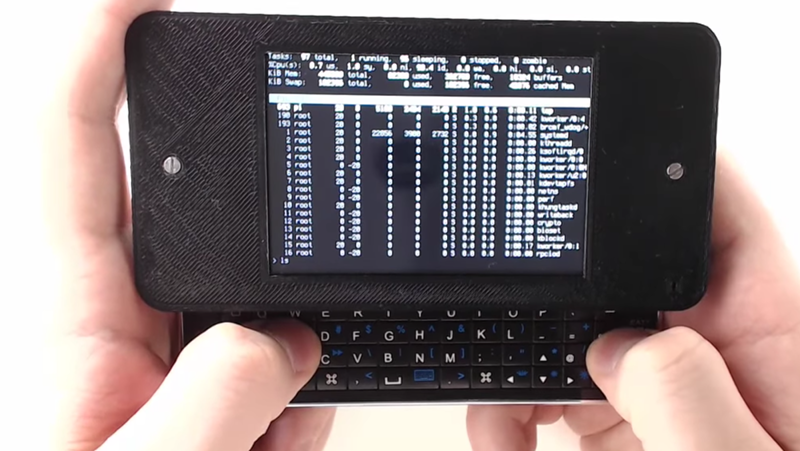There’s something to be said for economies of scale and few things sell more than cell phones. Maybe that’s why [NODE] took inspiration from an iPhone slide out keyboard case to create this Pi Zero W-based portable terminal. This is actually his third iteration, and in the video below he explains why he has built the new version.
By housing the custom bits in a 3D-printed frame that is size compatible with the iPhone, [NODE] manages to leverage the slick slide out keyboard cases available for the phone. The iPhone in question is an older iPhone 5, so the cases are inexpensive, compared to the latest generation. On the other hand, the iPhone 5 is recent enough that it shouldn’t be hard to find a compatible case.
The circuitry itself is pretty straightforward: a battery, a charge controller, and an LCD display. The only complaint we could see was the lack of a control key on the keyboard.
Being a terminal, we would have appreciated bringing a serial port out. On the other hand, there is a full-size USB connector so you could plug in a serial cable. There’s also a micro port for charging and a small HDMI connector, which means you could use an available HDMI device as a full-size screen if you like. Although you can see a prototype, [NODE] is still refining the 3D printed parts and plans to release them soon. Having seen the prototype, you can grab the dimensions of your target phone and duplicate something similar if you’re up for a challenge.
[NODE] clearly likes portable Linux systems since we’ve seen him cobbling together slightly larger laptops before. Of course, everyone loves the Pi and that’s why we’ve also been keeping our eye on the ZeroPhone. Of course many like to play games on their phones. If you’d rather play on a real iPhone, there’s always this simple method.
https://www.youtube.com/watch?v=YWlZ3B_hq_g&feature=youtu.be

















Reminds me an good old Nokia N900
Which reminds me of Maddox’s similar rant many moons ago :)
http://www.thebestpageintheuniverse.net/c.cgi?u=iphone
Cool build though :)
Same, they were brilliant, you can still buy them now and then, but they are now collectable so expensive. This Pi hack is a great substitute, but no self respecting Qeng Ho would accept anything less than a full HUD these days….
“On the other hand, the iPhone 5 is recent enough that it should be hard to find a compatible case.” I think you’re missing a “not” somewhere in that sentence…
would probably benefit from this!!
https://hackaday.io/project/20322-picb-tft
Tis cool for sure, but seeing linux with slider keyboard really just makes me sad that Nokia/Elop/Microsoft killed the Linux N-series line, a cool terminal but not a flagship grade phone or tablet. People worldwide clamored for even the de-keyboarded(vs the dev loan only N950) Maemo6/Meego Linux N9, but the ink was dry with the selling of Nokia’s soul to MSFT, then the company, and then the platform did truly burn to ashes.
Android uses a hacked kernel which is approaching convergence with mainline but it is not real linux until I can port a QT built app or even just x11 without needing to chroot.
True, I also truly miss maemo. I used to own N800, it was such a fun system to work with, in true linux spirit.
Also, I want to add, if you have an app purely written in Qt you can probably “easily” compile it for android.
Not being able to port a Qt or X11 app to Android has nothing to do with the kernel. X11 apps need an X server.
Qt apps are actually much easier to port than X11 apps, as Qt is designed from the ground up to work on different platforms with different display APIs. Qt apps can already be ported to Android.
I just miss physical keyboards on phones.
The keyboards were nice but they always came with so many compromises in other aspects of the design that I can’t bring myself to miss them, at least after the dawn of the smartphone era.
Could you please elaborate? I’m thinking of making a small standalone keyboard using the N900 plastic parts you can get from China, and a custom PCB, and I’m trying to understand if others would be interested in that as well.
Xbox 360 chatpad (touches finger to nose).
They are still available. I have two at the moment.
Sadly I appear to be one of the few Western Canadians to own a Psion, I’m seriously considering this:
https://www.indiegogo.com/projects/gemini-pda-android-linux-keyboard-mobile-device-phone/#/
But am a wee worried due to the Spectrum Vega+ debockle.
This is a hack: it makes something do what it wasn’t designed to do. These keyboard weren’t designed to be used with a Pi in a 3D-printed enclosure.
It looks like my Nintendo DS-based SSH terminal (which is also a hack since the DS wasn’t meant to be used as a terminal), but at least this one has a real physical keyboard instead of a virtual one displayed on a touchscreen. Resistive touchscreens are much better than capacitive ones anyway so an on-screen keyboard on a DS is actually usable (even Nintendo developed a text-based chat program for the DS which featured a very small keyboard). Also, having two separate screens for terminal and keyboard means it looks like a laptop for cats. No, that doesn’t mean cats can use it.
This build has one defect, though: the keyboard has its own battery and has to be switched on and charged independently. Removing that battery, leaving the power switch to “on” (if there is one) and powering the keyboard directly would be a better solution.
Resistive touchscreens better? riiiiiiiight.
Wireless keyboard is a great idea, if you want your password leaked.
Check out Noodle Pi. 19mm thin, with hi-res screen, battery, charger, camera, keyboard dock for mini backlit keyboard+trackpad. Completely DIYable in minutes without any tools. http://noodlepi.com